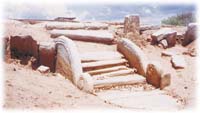| Plus |
|
|||||
|
Digging
up a maritime past Godavaya, the picturesque harbour town down South, is situated around a huge rock overlooking the Indian Ocean, the gem mining area of the Lower Sitracala Wewa and the inland shipping route of the Walawe Ganga. It seems almost like a modern harbour - but all this happened as far back as the 2nd century AD in Godapavata Pattana, west of Hambantota. Evidence is being unearthed every day to prove Godavaya's importance in the maritime Silk Route, with excavations and research revealing connections from China in the East to the Red Sea and the Mediterranean in the West. Once a year, Godavaya bounces back to life again as Sri Lankan and German archaeologists excavate the old Kingdom of Ruhuna to gather more evidence about its glorious past. Since 1994, a team from the University of Bonn, Germany, directed by Prof. Helmut Roth has been working with the Archaeological Department directed by Director General Dr. W.H. Wijeyapala and the German Archaeological Institut (DAI), conducting joint excavations here. Under the guidance
of Research Assistant Oliver Kessler, a team of 35 is presently
excavating the temple area of Gotha Pabbatha Rajamaha Vihara in
Godavaya. The temple area had been a religious and administrative centre since the reign of King Gajabahu I. A unique Brahmi inscription on a rock next to the ancient shrine room clearly states that this was indeed a significant sea-trading place. True to Sri Lankan tradition, Ahalaya, one of King Gajabahu's ministers, has immortalized himself by getting his name carved in another inscription on this rock. In ancient times, Sri Lanka was heavily involved in the export and import trade and exported dark red garnets that were in great demand in early medieval Europe. Upto the 7th century AD, these semi-precious stones were found as burial objects in many European graves and new research reveals that most of those garnets were from India and Sri Lanka. Another money-spinner for Sri Lanka had been spices. Sassanian (Persian) and Chinese pottery was also discovered as import cargo and Roman coins as early foreign currency. Ships from the
East carrying silk from China exchanged their commodities with merchandise
from the West in the transit harbour of Godavaya as trade ships
from both directions usually did not go farther than Sri Lanka.
Therefore, Ruhuna played an important role as a turntable of trade
and commerce in early East-West trade. This harbour town is mentioned in the Mahawamsa's chapter on "The 12 Kings". Even in early western books like the Topographia Christiana of the 6th century AD, Sri Lanka is referred to as an important sea trade centre on the Silk Route. Oliver Kessler points to an exciting excavation site on the east side of the ancient monastery: the custom office building, which was decorated with ornaments showing an elephant placing his trunk in lotus flowers. Normally, only the King was allowed to collect taxes. In Godavaya, the tax fees were donated to the temple for its maintenance. Clay seals bearing the emblem of a lion were used to seal goods and cargo as proof that the customs duty was paid. On top of the
rock overlooking the entire area was the monastery, which dates
back to the 2nd century AD. On the west side of the monastery an
elevated ancient image house (Buddhu gedera) and a chapter house
(Dharma salawa) were excavated. At the bottom of the rock was the settlement of Godapavata Pattana, sandwiched on the peninsula between the Walawe river's inland harbour and the sea harbour in the bay of Godavaya. "Many South Indian harbours carry the ending 'pattana" which means harbour," explains Oliver Kessler. Hence, close links existed between Lankan and South Indian harbours, because the Dravidian community organized the sea trade there. A landing jetty constructed of stone pillars upto 3.50 metres high was part of the ancient harbour. While doing an underwater survey, the excavation team found one of the four ancient stone anchors discovered so far in Sri Lanka, the other three being found in Galle. Several Roman coins, beads, bangles, bricks showing guild marks in the shape of an O, a huge selection of pottery and rich decorations used for roofs and houses give clear evidence of a once prosperous time. A quarry was also discovered. One big pillar covered with many drill marks dating to the middle Anuradhapura period before the 5th century AD, lies in front of the huge rock close to the ocean. "That is something spectacular, as there are not many quarries documented," Oliver Kessler reveals. In a few days, as these excavations end, Godavaya will disappear again under a thick layer of sand to be protected against the weather and souvenir hunters. Silence will return to the sacred area of the 2nd century AD monastery overlooking the Indian Ocean, where now fishermen are working hard for their daily catch. |
||||||
Copyright © 2001 Wijeya Newspapers
Ltd. All rights reserved. |
 collectors
are busy stamping the cleared freight with a lion seal.
collectors
are busy stamping the cleared freight with a lion seal.